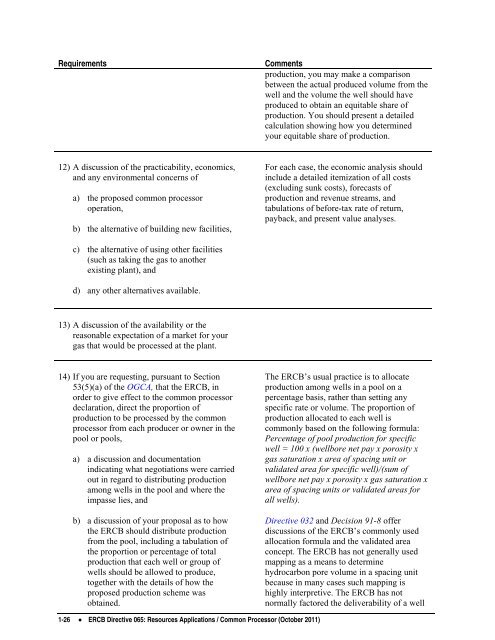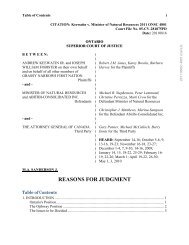Directive 065: Resources Applications for Oil and Gas Reservoirs ...
Directive 065: Resources Applications for Oil and Gas Reservoirs ...
Directive 065: Resources Applications for Oil and Gas Reservoirs ...
Create successful ePaper yourself
Turn your PDF publications into a flip-book with our unique Google optimized e-Paper software.
Requirements<br />
Comments<br />
production, you may make a comparison<br />
between the actual produced volume from the<br />
well <strong>and</strong> the volume the well should have<br />
produced to obtain an equitable share of<br />
production. You should present a detailed<br />
calculation showing how you determined<br />
your equitable share of production.<br />
12) A discussion of the practicability, economics,<br />
<strong>and</strong> any environmental concerns of<br />
a) the proposed common processor<br />
operation,<br />
b) the alternative of building new facilities,<br />
For each case, the economic analysis should<br />
include a detailed itemization of all costs<br />
(excluding sunk costs), <strong>for</strong>ecasts of<br />
production <strong>and</strong> revenue streams, <strong>and</strong><br />
tabulations of be<strong>for</strong>e-tax rate of return,<br />
payback, <strong>and</strong> present value analyses.<br />
c) the alternative of using other facilities<br />
(such as taking the gas to another<br />
existing plant), <strong>and</strong><br />
d) any other alternatives available.<br />
13) A discussion of the availability or the<br />
reasonable expectation of a market <strong>for</strong> your<br />
gas that would be processed at the plant.<br />
14) If you are requesting, pursuant to Section<br />
53(5)(a) of the OGCA, that the ERCB, in<br />
order to give effect to the common processor<br />
declaration, direct the proportion of<br />
production to be processed by the common<br />
processor from each producer or owner in the<br />
pool or pools,<br />
a) a discussion <strong>and</strong> documentation<br />
indicating what negotiations were carried<br />
out in regard to distributing production<br />
among wells in the pool <strong>and</strong> where the<br />
impasse lies, <strong>and</strong><br />
b) a discussion of your proposal as to how<br />
the ERCB should distribute production<br />
from the pool, including a tabulation of<br />
the proportion or percentage of total<br />
production that each well or group of<br />
wells should be allowed to produce,<br />
together with the details of how the<br />
proposed production scheme was<br />
obtained.<br />
The ERCB’s usual practice is to allocate<br />
production among wells in a pool on a<br />
percentage basis, rather than setting any<br />
specific rate or volume. The proportion of<br />
production allocated to each well is<br />
commonly based on the following <strong>for</strong>mula:<br />
Percentage of pool production <strong>for</strong> specific<br />
well = 100 x (wellbore net pay x porosity x<br />
gas saturation x area of spacing unit or<br />
validated area <strong>for</strong> specific well)/(sum of<br />
wellbore net pay x porosity x gas saturation x<br />
area of spacing units or validated areas <strong>for</strong><br />
all wells).<br />
<strong>Directive</strong> 032 <strong>and</strong> Decision 91-8 offer<br />
discussions of the ERCB’s commonly used<br />
allocation <strong>for</strong>mula <strong>and</strong> the validated area<br />
concept. The ERCB has not generally used<br />
mapping as a means to determine<br />
hydrocarbon pore volume in a spacing unit<br />
because in many cases such mapping is<br />
highly interpretive. The ERCB has not<br />
normally factored the deliverability of a well<br />
1-26 • ERCB <strong>Directive</strong> <strong>065</strong>: <strong>Resources</strong> <strong>Applications</strong> / Common Processor (October 2011)
















